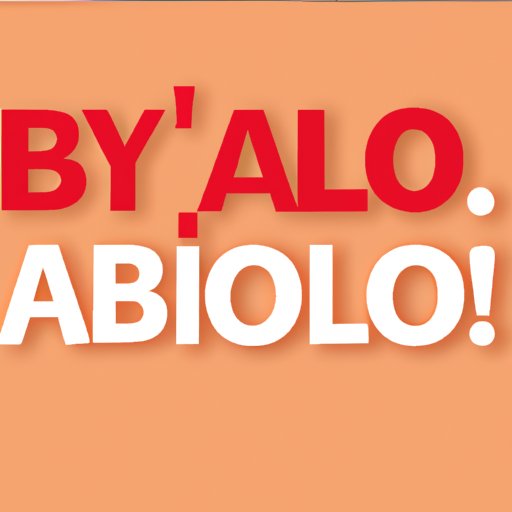
Introduction
Greetings are an important part of any culture, and Italian culture is no exception. Italian greetings are as diverse as the country’s cuisine, and the way you greet someone can have a huge impact on your interactions with them. In this article, we will explore different ways to say “hello” in Italian, how to add personality to your greetings, the importance of mastering Italian greetings, essential hellos to know, and practical tips for improving your Italian greetings.
5 Different Ways to Say Hello in Italian
Here are the five most common ways to say hello in Italian:
Ciao
“Ciao” is the most common and informal way to greet someone in Italian. It can be used to greet friends, family, or anyone you know well. “Ciao” can also be used to say goodbye.
Buongiorno
“Buongiorno” means “good morning” in Italian. You should use it to greet people in the morning or before noon. This greeting is more formal, so it is appropriate to use it in professional settings.
Buona sera
“Buona sera” means “good evening” in Italian. You should use it to greet people in the afternoon or evening. This greeting is also more formal, so it is suitable for professional settings and occasions.
Salve
“Salve” is a formal greeting and can be used at any time of the day. It is a bit less common than other Italian greetings, but it is still widely understood.
Buona notte
“Buona notte” means “good night” in Italian. You should use it to say farewell in the evening or before going to bed. This greeting is also more formal and commonly used in professional settings.
Each greeting is appropriate for different situations, so use them accordingly.
Spice Up Your Greetings: A Guide to Saying Hello in Italian
Saying hello in Italian is not just about getting the words right. You can add personality to your greetings and make a positive impression by using the right body language and tone.
Using Body Language and Tone
Your body language and tone can convey as much meaning as your words. Smile and make eye contact with the person you are greeting to show that you are happy to see them. Use a warm and friendly tone to convey your sincerity.
Tips for Adapting Greetings to Different Situations and People
You should adapt your greetings to fit different situations and people. Use more formal greetings in professional settings and occasions. Use more informal greetings when greeting friends and family.
Example Scenarios
Imagine you are introducing yourself to someone for the first time. You may want to use a more formal greeting like “Buongiorno” or “Salve”. If you are greeting someone casually, you may want to use “Ciao”. If you are saying goodbye to someone, you can use “Ciao” or “Buona notte”.
Master Italian Greetings with These 5 Ways to Say Hello
Mastering Italian greetings is important if you want to show respect and create a good impression. Here are some tips:
Practical Tips for Learning and Practicing Greetings
The best way to learn Italian greetings is to practice them regularly. Use them when greeting people in Italian, even if they speak English. Consistency is key, so practice every day until the greetings flow naturally.
Common Mistakes to Avoid
One common mistake when speaking Italian is mispronouncing certain words. Make sure to stress the right syllables in each word and use the correct intonation.
Example Exercises and Activities
You can practice Italian greetings by writing them down, listening to Italian radio or music, and watching Italian films or TV shows.
Greeting Like a True Italian: Essential Hellos to Know
There are certain essential Italian hellos that you should know:
Buongiornissimo/Buonanotte
These are more emphatic versions of “good morning” and “good night”. They are used to express extra enthusiasm or to create a more dramatic effect.
Ciao bella or Ciao bello
This greeting is often used to compliment someone’s looks, so use it only if you know the person well.
Arrivederci
“Arrivederci” means “goodbye” in Italian. It is a more formal way of saying goodbye than “Ciao”. Use it in professional and formal settings.
Piacere di conoscerti
This means “nice to meet you” in Italian. Use it when you are introduced to someone for the first time.
How to Say Hi in Italian: A Beginner’s Guide
Now that you know the different ways to say hello in Italian, how to add personality to your greetings, the importance of mastering Italian greetings, essential hellos to know, and practical tips for improving your Italian greetings, it’s time to put it all together.
Suggestions on Finding the Right Greeting for Any Occasion
The best way to find the right greeting for any situation is to consider the context and the person you are greeting. Choose the greeting that is appropriate, whether it is formal or informal.
Tips for Improving Pronunciation and Confidence in Using Italian Greetings
The more you practice, the better you become at speaking Italian. Use resources like language courses, audio programs, and language apps to improve your pronunciation and confidence.
Additional Resources for Learning Italian Greetings
There are many resources available online that can help you learn Italian greetings. Some of them include Duolingo, Babbel, and Rosetta Stone.
Conclusion
In conclusion, greetings are an important part of Italian culture, and saying hello in Italian can significantly impact your interactions with people. We have explored the different ways to say hello in Italian, how to add personality to your greetings, the importance of mastering Italian greetings, essential hellos to know, and practical tips for improving Italian greetings. Use these tips and suggestions to make a great impression the next time you greet someone in Italian, and remember to practice regularly!
Final Tips and Recommendations for Using Italian Greetings Effectively
Be confident and use the right context to show respect. Remember, a warm and friendly greeting can go a long way in making a great first impression in Italian culture.




